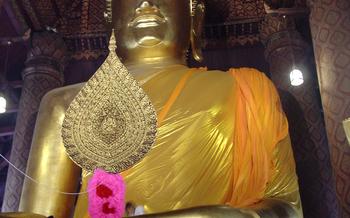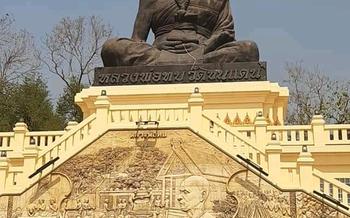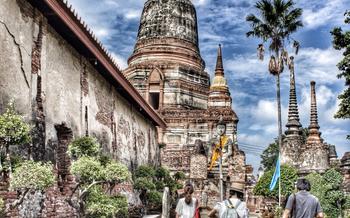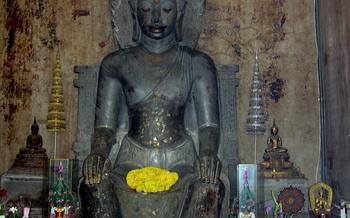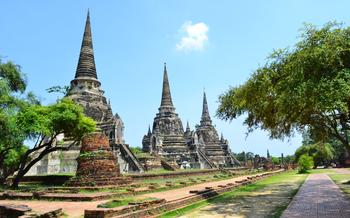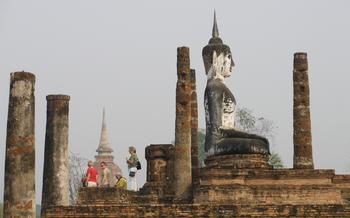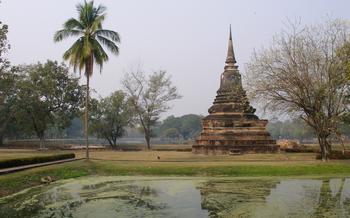
Wat Woranat Banphot (Wat Khiriwong)
- Atop the Hill
- Grand Stairway
- Ubosot Hall: A Sanctuary of Sacred Murals and Paintings
- Buddha Statues
- Temple Grounds
- Ordination Hall
- Monastery
- Festivals and Events
- Pilgrimage Site
- Local Community
- Photography Opportunities:
- Dress Code
- Local Markets
- Insider Tip:
Atop the Hill
Wat Woranat Banphot, also known as Wat Khiriwong, stands majestically atop a hill overlooking the serene landscape of Nakhon Sawan, Thailand. Its historical roots trace back to the late 19th century when Somdet Phra Wannarat, the then abbot of Wat Pho in Bangkok, envisioned a temple that would serve as a center for Buddhist teachings and meditation. The architectural style of the temple is a blend of traditional Thai and European influences, showcasing intricate carvings, colorful murals, and a unique fusion of design elements. Its elevated location not only offers breathtaking panoramic views of the surrounding countryside but also symbolizes the temple's spiritual significance, representing the journey towards enlightenment and the transcendence of worldly desires.
Grand Stairway
A majestic entrance awaits visitors as they approach Wat Woranat Banphot, featuring a grand stairway that leads to the temple's main grounds. This impressive staircase holds immense cultural significance, symbolizing the journey towards spiritual enlightenment and the ascent to higher realms.
The steps are meticulously adorned with intricate designs and sculptures, each narrating a story from Buddhist mythology and teachings. Ascending the staircase offers a sense of pilgrimage, a physical and metaphorical journey towards the sacred spaces that await at the temple's peak.
Along the stairway, panoramic views of the surrounding landscape unfold, inviting visitors to pause and appreciate the beauty of nature and the temple's harmonious integration with its surroundings. The staircase also presents numerous photo opportunities, allowing visitors to capture the grandeur and serenity of this sacred site.
Ubosot Hall: A Sanctuary of Sacred Murals and Paintings
The heart of Wat Woranat Banphot lies within the Ubosot Hall, a central shrine room exuding an air of sacredness and reverence. Intricate murals and paintings adorn the walls and ceiling, narrating tales from Buddhist scriptures and depicting significant events in the life of Lord Buddha. These exquisite artworks not only serve as visual masterpieces but also hold profound religious and cultural significance.
The Ubosot Hall houses several sacred Buddha images, each radiating a unique aura of tranquility and serenity. The principal Buddha statue, known as Phra Buddha Chinarat, is a highly revered and cherished icon among Thai Buddhists. Devotees flock to the temple to pay homage to this sacred image, seeking blessings, guidance, and spiritual solace.
When entering the Ubosot Hall, visitors are expected to observe proper etiquette and customs. It is customary to remove one's shoes before stepping onto the elevated platform and to maintain a respectful demeanor throughout the visit. Visitors should refrain from speaking loudly or engaging in disruptive behavior, honoring the sanctity of this sacred space.
Buddha Statues
Within the temple grounds, visitors will encounter a variety of Buddha statues, each representing different postures, mudras (hand gestures), and cultural significance. These statues are primarily revered as embodiments of the Buddha's teachings and ideals. The most prominent Buddha statue is the Phra Woranat Banphot, the principal Buddha image of the temple. This magnificent statue is seated in the posture of meditation, exuding a serene and compassionate aura. Its intricate details and gold leaf adornments add to its grandeur, making it a focal point of worship and devotion.
Other notable Buddha statues include the Phra Sangkajai, known for its healing powers and ability to bestow good fortune. Devotees often pray to this statue for blessings, especially during times of illness or hardship. The Phra Trai Ratana Nayok, representing the three treasures of Buddhism – the Buddha, the Dharma, and the Sangha – is another revered statue. Its presence in the temple serves as a reminder to practitioners of the core principles of the Buddhist faith.
When visiting the temple, it is customary to pay respect to the Buddha statues by offering prayers, lighting incense, and making offerings of flowers or food. Visitors should maintain a respectful demeanor, avoiding pointing their feet towards the Buddha statues and speaking in a calm and subdued tone. By observing these customs, visitors can demonstrate their reverence for the sacredness of the temple environment.
Temple Grounds
The temple grounds of Wat Woranat Banphot are a sanctuary of tranquility and peace, enveloped in lush greenery, vibrant gardens, and a serene atmosphere that invites meditation and contemplation. Visitors are greeted by a symphony of colors and textures as they wander through the meticulously manicured gardens, where meaningful trees, plants, and flowers hold deep cultural and religious significance. The temple's serene surroundings offer a respite from the bustling city, allowing visitors to immerse themselves in the tranquility of nature and the sacredness of the Buddhist teachings.
The trees that grace the temple grounds are not mere ornaments but revered symbols of strength, longevity, and spiritual growth. The towering banyan trees, with their intricate root systems and sprawling branches, embody the interconnectedness of all living beings and the enduring nature of life. The sacred fig trees, with their heart-shaped leaves and bountiful fruit, represent fertility, abundance, and the attainment of enlightenment. Visitors can also find bodhi trees, under which the Buddha is said to have attained enlightenment, serving as a reminder of the path to wisdom and liberation.
The flowers that bloom within the temple grounds are not just aesthetically pleasing but also hold symbolic meanings. The fragrant lotus flowers, emerging from muddy waters, represent purity, resilience, and spiritual transformation. The jasmine flowers, with their delicate white petals and intoxicating scent, symbolize purity, love, and devotion. Visitors can also find marigolds, often used in Buddhist offerings, representing joy, prosperity, and longevity.
These meaningful trees, plants, and flowers, combined with the serene atmosphere of the temple grounds, create a sacred space that encourages visitors to slow down, reflect, and connect with their inner selves. Whether seeking solace, seeking wisdom, or simply enjoying the beauty of nature, the temple grounds of Wat Woranat Banphot offer a sanctuary of peace and tranquility for all who visit.
Ordination Hall
The ordination hall, or Bot, holds a significant place within the temple grounds, serving as a sacred space for the initiation of young men into the Buddhist monastic order. Within its walls, aspiring individuals undergo the sacred ceremony of ordination, embracing a life of spiritual devotion and discipline. The ordination hall stands as a testament to the enduring legacy of Buddhism in Thailand, where the act of becoming a monk is highly revered and respected.
During ordination ceremonies, the candidates, known as **naks", don saffron robes and make a solemn commitment to follow the Buddhist precepts. The ceremony is presided over by senior monks who guide the nak through the rituals and teachings that mark the beginning of their monastic journey. The ordination hall reverberates with the chanting of sacred mantras and the blessings bestowed upon the new monks.
The ordination hall not only serves as a venue for ordinations but also as a place for monks to gather for daily prayers and meditation sessions. The serene and contemplative atmosphere within the hall fosters a deep connection with the teachings of the Buddha, providing a sanctuary for spiritual growth and self-reflection.
Monastery
The monastery at Wat Woranat Banphot is a serene sanctuary for monks and novices who dedicate their lives to studying and practicing Buddhism. These devoted individuals reside within the temple grounds, immersing themselves in spiritual teachings and living according to the monastic code.
Their daily routine begins with morning prayers and meditation, followed by studying Buddhist scriptures and practicing mindfulness techniques. They engage in various tasks to maintain the temple, such as cleaning, gardening, and assisting with ceremonies. Monks also offer guidance and support to the local community, providing spiritual counseling and blessings to those in need.
Monasteries play a crucial role in preserving Thai Buddhist traditions and passing down the teachings of the Buddha to future generations. By observing the monks' simple and disciplined way of life, visitors can gain insights into the essence of Buddhism and the profound impact it has on Thai culture.
Festivals and Events
Wat Woranat Banphot is not only a place of worship but also a vibrant hub for cultural and religious festivals throughout the year. The most prominent event is the annual temple fair, held during the Songkran festival in April. This lively celebration features merit-making ceremonies, colorful processions, and traditional Thai performances, attracting thousands of devotees and visitors. During the fair, the temple grounds transform into a bustling marketplace, where vendors sell delicious local delicacies, handmade crafts, and souvenirs. Participating in these festivals is a fantastic way to immerse yourself in the local traditions, experience the vibrant Thai culture, and connect with the community.
Pilgrimage Site
Wat Woranat Banphot holds a significant position as a revered pilgrimage site for devotees and visitors seeking spiritual fulfillment. The temple's sacred aura and history attract numerous pilgrims throughout the year who come to pay homage, make offerings, and seek blessings.
Pilgrimage to Wat Woranat Banphot is considered an auspicious act in Thai culture, as it is believed to bring merit and good fortune. Devotees often undertake pilgrimages during important religious festivals or on special occasions to strengthen their spiritual connection and receive blessings from the temple's revered Buddha images and sacred relics.
During pilgrimage visits, devotees engage in various religious rituals and practices. They may offer flowers, candles, and incense to the Buddha statues, chant mantras, and meditate in the temple grounds to purify their minds and seek spiritual guidance. Some pilgrims may also participate in merit-making activities, such as donating to the temple or offering food to the resident monks.
The pilgrimage experience at Wat Woranat Banphot is deeply immersive, allowing visitors to connect with the local religious traditions and gain a deeper understanding of Thai Buddhist beliefs. It is an opportunity for spiritual reflection, personal growth, and the cultivation of inner peace.
Local Community
Interacting with the local community and monks at Wat Woranat Banphot is a fulfilling experience. The people here are friendly and welcoming, eager to share their way of life, beliefs, and customs with visitors. Strike up a conversation with the monks to learn about their daily routines, religious practices, and the history of the temple. They are often happy to answer questions and provide insights into Thai Buddhist culture.
Supporting the local community is essential for preserving the temple and its traditions. Visitors can make donations to the temple, which help maintain the grounds and support the monks' livelihood. Participating in merit-making ceremonies is another way to contribute to the temple and gain spiritual merit. These ceremonies involve offering food, flowers, and other items to the monks as a way of showing gratitude and respect.
Photography Opportunities:
Photography Opportunities:
The beauty and grandeur of Wat Woranat Banphot present an irresistible opportunity for photography enthusiasts. The temple offers a plethora of stunning photo spots and angles to capture its architectural marvels and serene surroundings. The towering chedi, intricate murals, and panoramic views from the grand staircase provide captivating subjects for photographers. To take memorable photos, consider arriving early in the morning or late in the afternoon to capture the temple's best light. Using a wide-angle lens can help you capture the scale and majesty of the temple, while a telephoto lens can bring out the details of the intricate carvings and murals. Remember to respect the sacredness and serenity of the temple by maintaining silence and avoiding using flash photography.
Dress Code
When visiting Wat Woranat Banphot, it is essential to adhere to the appropriate dress code as a sign of respect for the sacredness of the temple. Visitors should dress modestly and avoid wearing revealing or overly casual clothing. For women, it is recommended to wear a skirt or pants that cover the knees, and a top that covers the shoulders. Men should wear long pants and a shirt with sleeves. Shorts, tank tops, and flip-flops are generally not considered appropriate attire for the temple. It is important to be mindful of local customs and traditions, and to dress in a way that is respectful of the religious significance of the site.
Local Markets
A visit to Wat Woranat Banphot can be complemented by exploring the bustling local markets nearby. Just a short walk from the temple, visitors can immerse themselves in the vibrant atmosphere of these markets, where vendors display a variety of souvenirs, local delicacies, and handicrafts. From intricate wood carvings and colorful fabrics to aromatic spices and fresh produce, the markets offer a glimpse into the local culture and way of life.
Bargaining is a common practice in Thai markets, and visitors are encouraged to engage in friendly negotiations with the vendors. This not only allows for a more favorable price but also provides an opportunity to connect with the locals and learn about their customs. Visitors should approach bargaining with a smile and a respectful attitude, always keeping in mind that the vendors are earning a living and should be treated with courtesy.
Supporting local vendors by purchasing souvenirs and trying local delicacies is a great way to contribute to the community's economy and preserve traditional livelihoods. The markets are also a fantastic place to practice basic Thai phrases and interact with the friendly locals, creating a memorable and authentic travel experience.
Insider Tip:
Best Time to Visit: Aim to visit Wat Woranat Banphot early in the morning or late in the afternoon to avoid the midday heat and crowds. The temple is at its most serene and peaceful during these times, allowing you to fully appreciate its beauty and tranquility.
Hidden Gems: Explore the lesser-known areas of the temple complex, such as the meditation gardens, the monk's quarters, and the ordination hall. These spots offer unique perspectives and insights into the daily life and practices of the monks residing at the temple.
Special Events: Check for upcoming festivals or special events held at the temple throughout the year. These events, such as merit-making ceremonies, processions, and cultural performances, provide a chance to witness Thai Buddhist traditions and participate in the vibrant local culture.
